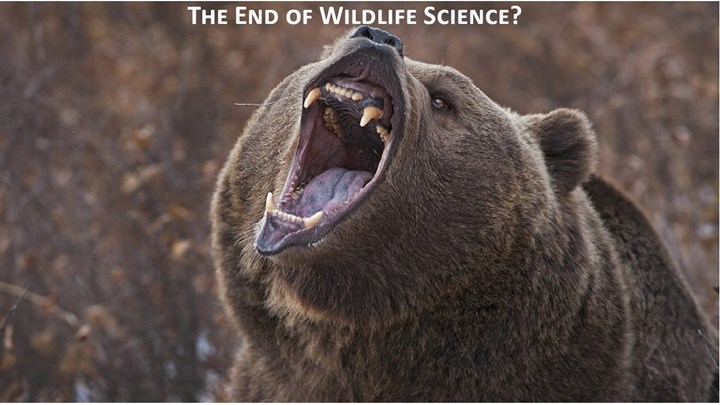
by Brian McCombie - Tuesday, September 25, 2018

Yesterday, Sept. 24, Federal U.S. District Judge Dana Christensen decided he knew more than scores of wildlife biologists and other conservation professionals when he ruled that the U.S. Fish and Wildlife Service (USFWS) was wrong when in March 2016 it moved to delist the grizzly bears in the Greater Yellowstone Ecosystem (GYE) from Endangered Species Act (ESA) protections. In overturning the USFWS’ decision, Judge Christensen effectively ended the State of Wyoming’s pending 2018 grizzly bear hunt despite that the bears meet or exceed carrying capacity.
In a press release issued by the Wyoming Game and Fish Department, fellow sportsman and Wyoming Gov. Matt Mead said, “I am disappointed with today’s decision. Grizzly bear recovery should be viewed as a conservation success story.”
We hunter-conservationists couldn’t agree more. Following Wyoming’s investment of approximately $50 million for recovery and management, the GYE grizzly bear population has exceeded every scientifically established recovery criteria since 2003. As Gov. Mead and this website have reported multiple times, the population has risen from as few as 136 bears when they were listed in 1975 to more than 700 today.
Outlining the process of delisting species from ESA protections, Gov. Mead emphasized, “Biologists correctly determined grizzly bears no longer needed ESA protections. The decision to return grizzly bears to the list of threatened and endangered species is further evidence that the ESA is not working as its drafters intended. Congress should modernize the ESA so we can celebrate successes and focus our efforts on species in need.”
Commenting on the decision for the NRA was NRA-ILA Associate Litigation Counsel Michael Jean, who has been involved in the issue since animal rights extremists groups began filing lawsuits to shut down the proposed GYE grizzly bear hunts. “The bears are recovered and are thriving overall, but the court—like other courts have done in the past—held that the U.S. Fish and Wildlife Service's decision to delist the bears was procedurally deficient. Now the USFWS and the states are going to have to continue spending conservation resources on these bears that should be spent on other wildlife species that aren't doing so well.”
Weighing in on Judge Christensen’s decision for the Wyoming Fish and Game Department (WFGD), WFGD Director Scott Talbot said, “Game and Fish is a strong proponent of all wildlife management being led by people who live in this state and in having management decisions made at the local level.”
In tracking the issue, this website previously reported that Judge Christensen had already blocked the bear hunt twice, in two-week increments, to consider claims by animal rights groups’ attorneys insisting that federal ESA regulations be restored to the bears. The NRA-ILA and other conservation-minded organizations opposed the delays, pointing to the very successful work by federal and state biologists to help restore the region’s grizzly bear numbers. Efforts have been so successful that not only are grizzly bears fully recovered but human-grizzly conflicts are now on the rise as are reports of the big bruins preying on livestock.
Of note, this decision comes as NRAHLF.org just reported on a fatal grizzly bear attack on hunting guide Mark Uptain in Wyoming near the border of Grand Teton and Yellowstone national parks. Unfortunately, we can expect increased encounters with humans and the loss of cattle and other livestock to create even more backlash in the future. The NRA HLF will continue to report on these incidents as they arise.
As ABC News.com reported, in his ruling Christensen noted “an estimated 50,000 bears once roamed the contiguous United States and said it would be ‘simplistic at best and disingenuous at worst’ not to consider the status of grizzlies outside the Yellowstone region, one of the few areas where they have bounced back.”
Given this report, one must wonder if the judge truly realizes what “recovery” means under the ESA. There may well have been 50,000 grizzlies roaming the Lower 48 at one time, but that was before European settlement and development of the country, including our Western states. ESA recovery is about creating sustainable populations of endangered and threatened species—not about returning these populations to pre-settlement numbers.
It is hoped that once the wildlife scientists are convinced these populations have been established and are sustaining themselves that scientifically-based hunting can resume—unless, of course, a judge decides otherwise.
Editor’s Note: In response to the culture war on American hunters, in late 2014 the NRA launched the NRA Hunters’ Leadership Forum (HLF) to address the cultural, political, demographic and technological challenges facing the future of hunters, hunting and wildlife conservation in the 21st century. The HLF brings together dedicated hunters who have distinguished themselves as leaders in their professions, communities and in the field as the collective hunting community goes on the offense and works together to save hunting's future. Launched in July 2016, the NRA HLF website monitors issues impacting the future of hunting and wildlife conservation on the state, national and international levels and shares the stories of hunters and hunting and where our hard-earned dollars go. Without hunting, there would be no conservation! Visit NRAHLF.org for all of the above and share the story links.
E-mail your comments/questions about this site to:
[email protected]
